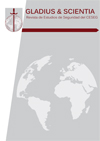Modificando el pasado y el presente para manipular el futuro: herramientas para combatir la alteración consciente del discurso histórico y fáctico con fines espurios
Contido principal do artigo
Resumo
El desarrollo de las nuevas tecnologías de la información y la comunicación (TICs) ha conllevado una transformación absoluta del panorama mediático global. De resultas de ello, día tras día y cada vez con mayor frecuencia hemos de enfrentarnos a una avalancha de noticias, a través de medios convencionales y de medios novedosos, que complican el proceso de información del individuo y de la sociedad respecto a la realidad que les rodea. En definitiva, estamos expuestos a un volumen de datos cada vez mayor, pero carecemos de las herramientas precisas para procesarlos y extraer la información veraz a partir de ellos. Incorporando la perspectiva filosófica, psicológica y pedagógica, entendemos que la capacidad de juicio crítico incluye la habilidad para argumentar análisis, emitir juicios o realizar inferencias. Las tres capacidades resultan fundamentales cuando leemos información y noticias sobre el pasado reciente, o sobre nuestro contexto social en general: en la medida en que analizamos una noticia estamos realizando inferencias, a través de deducciones, inducciones o hipótesis; emitimos juicios, evaluando la información; y analizamos discursos.
Palabras chave
Detalles do artigo
Citas
AIMC (2022). Marco general de los medios en España 2022. https://www.aimc.es/a1mc-c0nt3nt/uploads/2022/01/marco2022.pdf
Anderson, L.A.; Krathwol, D.R.; Airasian, P.W.; Cruikshank, K.A.; Mayer, R.E.; Pintrich, P.R.; Raths, J.; Wittrock, M.C. (2001). A Taxonomy for Learning, Teaching, and Assessing. Longman.
Archive.org (2005). The 4,000 Jews Rumor. Rumor surrounding September 11th proved untrue. https://web.archive.org/web/20050408072925/http://usinfo.state.gov/media/Archive/2005/Jan/14-260933.html
Aristóteles (355 A.C. 2013). Metafísica (Trad. de Azcárate, P.). Ed. Austral.
Austin, J. L. (1970). Philosophical Papers. Oxford University Press.
Bloom, B. S.; Engelhart, M. D.; Furst, E. J.; Hill, W. H.; Krathwohl, D. R. (1956). Taxonomy of educational objectives: The classification of educational goals. Vol. Handbook I: Cognitive domain. David McKay Company.
Castro, E. (2019). C. S. Peirce, William James y John Dewey | Historia de la filosofía (46/61) [Vídeo]. Youtube. https://youtu.be/lLrfpZ-O10o
Fassin, D. (2008). The humanitarian politics of testimony. Subjectification through trauma in the Israeli-Palestinian conflict. Cultural Anthropology, 23(3): 531-558.
Grant, L. (2011). The Hate that Will Not Die. The Guardian, 18-12-2001. https://www.theguardian.com/world/2001/dec/18/september11.israel
Hinchliffe, S. (ed. 2014). Securing Life: New Hazards and Biosecurity. En P. Cloke, P. Crang y M. Goodwin (eds.), Introducing Human Geographies (pp. 864-877). Routledge.
Huntington, S.P. The Clash of Civilisations and the Remaking of World Order. Simon & Schuster.
IFLA (2017, 1 de febrero). How To Spot Fake News – IFLA in the post-truth society. https://www.ifla.org/news/how-to-spot-fake-news-ifla-in-the-post-truth-society/
Kant, I. (1787). Crítica de la razón pura. (Traducción de Pedro Ribas). Alfaguara.
Kelly, M.E., Duff, H., Kelly, S. et al. (2017). The impact of social activities, social networks, social support and social relationships on the cognitive functioning of healthy older adults: a systematic review. Syst Rev, 6 (259) https://doi.org/10.1186/s13643-017-0632-2
Kirkham, R. (1992), Theories of Truth: A Critical Introduction. MIT Press, Cambridge, MA.
Kreeft, P. (2014). Summa Teológica Mínima. Los pasajes filosóficos esenciales de la Summa teológica de Santo Tomás de Aquino (Filosofía - Los esenciales de la Filosofía). Ed. Tecnos.
Lai, E. (2011). Critical Thinking: a Literature Review. Pearson’s Research Reports.
Maldita.es (2017, 10 de diciembre). Conoce al equipo. https://maldita.es/quienes-somos/
Martínez Luna, S. (2019). Cultura visual. La pregunta por la imagen. Sans Soleil.
Mikovits, J.A. (2021). Truth About Masks: Exploring Theories Against Wearing Them. Skyhorse Publishing.
Platón (370 A.C./2011). La República o el Estado (Trad. Miguel Candel). Ed. Austral.
Rodríguez, V. (2022). Qué dice Rusia oficialmente de la masacre de Bucha y qué demuestran las imágenes verificadas. Eldiario.es, 06-04-2022. https://www.eldiario.es/internacional/rusia-masacre-bucha-montaje-imagenes-verificadas_1_8888826.html
Russell, B. (1912). The Problems of Philosophy. Oxford University Press.
Short, T. L. (2007). Peirce’s Theory of Signs. Cambridge University Press.
Similar web (2022). Abc.es. https://www.similarweb.com/website/abc.es/#competitors
Similar web (2022). Elmundo.es. https://www.similarweb.com/website/elmundo.es/#overview
Similar web (2022). Elpais.com. https://www.similarweb.com/website/elpais.com/#overview
Spinoza, B. (1667/2011). Ética: demostrada según el orden geométrico. Ed. Alianza.
Stern, D.L., Kelly, M. y Parker, C. (2022). Bodies, rubble line the streets of Bucha following Russian retreat. The Washington Post, 02-04-2022. https://www.washingtonpost.com/world/2022/04/02/bucha-bodies-russia-retreat-kyiv/
Thorn, V. (2011). 9-11 Made in Israel. The Plot Against America. Sisyphus Press.
Van Vleet, J. (2021). Informal Logical Fallacies. A Brief Guide. Hamilton Books.
Wodak, R. Meyer, M. (2016). Methods of critical discourse studies (3rd ed.). Sage.






